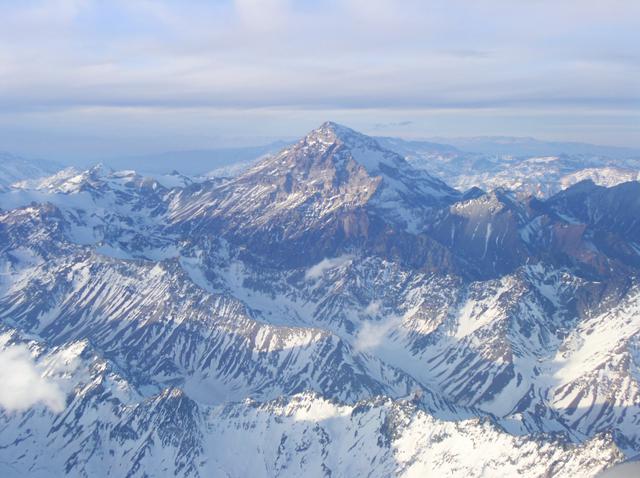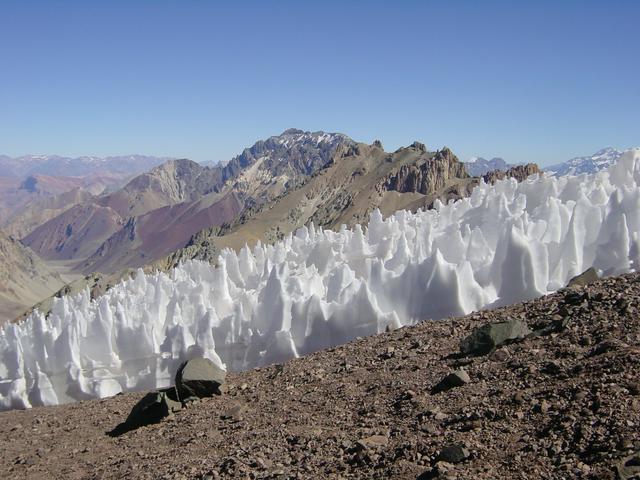 Aconcagua is a mountain in the Mendoza province of Argentina, not far from the Chilean border.
Aconcagua is a mountain in the Mendoza province of Argentina, not far from the Chilean border.
At 6,961 m (22,837 ft), Aconcagua is the highest mountain outside of Asia. It's also one of the Seven Summits and part of the Aconcagua Provincial Park, founded in 1983. The name comes from Quechua and means "white guard" or "stone guard".
Aconcagua has the second highest topographical prominence in the world, the closest higher mountain is 16,520 km away.
The first official ascent took place on 14 January 1897 by the Swiss mountain guide Matthias Zurbriggen, on his fifth attempt. The rich English adventurer Edward Fitzgerald whom he was guiding didn't reach the summit himself due to health problems.
In 1947 a guanaco skeleton was found on the ridge connecting the main and the southern summit, and in 1985 a well preserved mummy was found on the southwestern ridge at an altitude of 5200 m. These discoveries support the hypothesis that Aconcagua (just like other mountains in the Andes) were summited by native people before the arrival of the Europeans.
The mountain is situated in a high-altitude desert with little water and vegetation. Because of this, there different rocks composed of different minerals in different colors (green for copper, red for iron) are visible. Other things you can see are remains from the mining industry.
The best time to visit Aconcagua is the Austral summer from mid-December to late March.
There are big differences between day and night temperatures and weather conditions change frequently. The only constant thing is the strong winds, therefore you should practice setting up your tent before beginning the expedition. Anything with a large surface that the wind could catch needs to be tied up — bring a lot of rope.
The nearby Pacific Ocean has an influence on the weather, and storms coming in from there can very quickly create extreme weather conditions. This is called the Viento Blanco ("white wind"), and can turn sunny and calm mountain weather into a thunderstorm with heavy snowfall and hurricane-force winds in just a few hours.
Permits for the full-day trek in the Anconcagua Provincial Park are only sold until 11:30 in the morning, so ensure you arrive at the park visitor's center before 11:30am. Prices vary depending on your nationality (foreigners need to pay in hard currency, ie. USD) and whether you are trekking independently (slightly more expensive) or with a company.

- Penitentes. Ice formations that can be several meters high have emerged due to the strong sun radiation in the high altitude regions near the Equator.
- Mountaineer cemetery. The final resting place for the victims of the mountains.
Penitentes. Ice formations that can be several meters high have emerged due to the strong sun radiation in the high altitude regions near the Equator.
Mountaineer cemetery. The final resting place for the victims of the mountains.
- Casa Orviz, +54-261-4251281. Mountaineering equipment store in Mendoza.
Casa Orviz, +54-261-4251281. Mountaineering equipment store in Mendoza.
Except for the rather expensive hotel near the base camp, the last restaurants before the climb (and first after) are in Puente del Inca and Punta de Vacas. In the national park itself there are no places to stock up on provisions. Therefore, expect the normal "mountaineer fare", heated on portable stoves.
There are reports of mountaineers having found their food and equipment depots looted. If you leave things behind for some time such as at a high camp, make an agreement with other climbing groups to watch each others belongings.
Drinking water is obtained from the streams, originates from molten ice and snow, and should be boiled before drinking. Due to the altitude, the boiling point of water is lower (for instance at the base camp it's +86°C), so a good alternative is to use disinfection pills.There were as of January 2009 no hygienic issues with the water, but the water has a high magnesium content which has a laxative effect. The local doctors recommend using anti-diarrheal medicine to cope with this.
According to the park rules, you need to take your trash with you out of the park. This also includes your feces, and plastic bags are handed out at the park entrance for this purpose. Above the base camp the park rangers aren't really able to enforce this rule, moreover it doesn't apply to mules. The latrines next to the main routes are notable from far away by the smell.
Altitude sickness is a real risk, consult that article for details.
